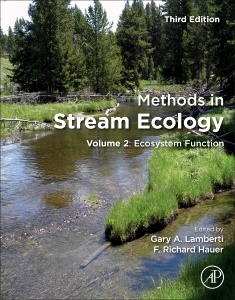Description
Methods in Stream Ecology (3rd Ed.)
Volume 2: Ecosystem Function
Coordinators: Lamberti Gary, Hauer F. Richard
Language: English
Subject for Methods in Stream Ecology:
372 p. · 21.5x27.6 cm · Paperback
Description
/li>Contents
/li>Biography
/li>Comment
/li>
Methods in Stream Ecology: Volume 2: Ecosystem Structure, Third Edition, provides a complete series of field and laboratory protocols in stream ecology that are ideal for teaching or conducting research. This new two-part edition is updated to reflect recent advances in the technology associated with ecological assessment of streams, including remote sensing. Volume two covers community interactions, ecosystem processes and ecosystem quality.
With a student-friendly price, this new edition is key for all students and researchers in stream and freshwater ecology, freshwater biology, marine ecology and river ecology. This book is also supportive as a supplementary text for courses in watershed ecology/science, hydrology, fluvial geomorphology and landscape ecology.
Methods in Stream Ecology, 3rd Edition, Volume 1: Ecosystem Structure, is also available now!Section D Organic Matter Dynamics 23. Stable Isotopes in Stream Food Webs 24. Dissolved Organic Matter 25. Transport and Storage of Fine Particulate Organic Matter 26. Coarse Particulate Organic Matter: Storage, Transport, and Retention 27. Leaf-Litter Breakdown 28. Riparian Processes and Interactions 29. Dynamics of Wood
Section E Ecosystem Processes 30. Conservative and Reactive Solute Dynamics 31. Nutrient Limitation and Uptake 32. Nitrogen Transformations 33. Phosphorus Limitation, Uptake, and Turnover in Benthic Stream Algae 34. Stream Metabolism 35. Secondary Production and Quantitative Food Webs 36. Elemental Content of Stream Biota
Section F Ecosystem Assessment 37. Ecological Assessment With Benthic Algae 38. Macroinvertebrates as Biotic Indicators of Environmental Quality 39. Environmental Quality Assessment Using Stream Fishes 40. Establishing Causee Effect Relationships in Multistressor Environments
F. Richard (Ric) Hauer, is Director of the University of Montana’s Center for Integrated Research on the Environment (CIRE) and Professor of Stream Ecology at the Flathead Lake Biological Station where he taught Stream Ecology for >25 years. His major research interests encompass the broad, interdisciplinary field of ecosystem ecology with focus on freshwaters, especially running waters and gravel-bed river floodplains and wetlands. The breadth of his research spans from physical processes of sediment transport and groundwater/surface water interactions to aquatic insect life histories and ecosystem assessment. He is particularly interested in the application of remotely sensed data to understanding biophysical processes of floodplain e
- Provides a variety of exercises in each chapter
- Includes detailed instructions, illustrations, formulae and data sheets for in-field research for students
- Presents taxonomic keys to common stream invertebrates and algae
- Includes website with tables and a links written by leading experts in stream ecology
These books may interest you

Marine Ecological Processes 116.04 €



